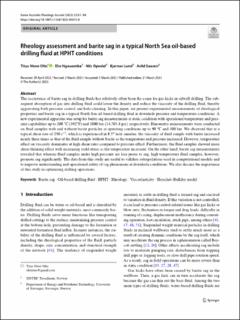| dc.contributor.author | Ofei, Titus Ntow | |
| dc.contributor.author | Ngouamba, Elie | |
| dc.contributor.author | Opedal, Nils van der Tuuk | |
| dc.contributor.author | Lund, Bjørnar | |
| dc.contributor.author | Saasen, Arild | |
| dc.date.accessioned | 2023-07-06T10:38:05Z | |
| dc.date.available | 2023-07-06T10:38:05Z | |
| dc.date.created | 2023-04-20T12:35:32Z | |
| dc.date.issued | 2023 | |
| dc.identifier.citation | Korea-Australia Rheology Journal. 2023, 35, 81-94. | en_US |
| dc.identifier.issn | 1226-119X | |
| dc.identifier.uri | https://hdl.handle.net/11250/3076540 | |
| dc.description.abstract | The occurrence of barite sag in drilling fluids has relatively often been the cause for gas kicks in oilwell drilling. The subsequent absorption of gas into drilling fluid could lower the density and reduce the viscosity of the drilling fluid, thereby aggravating both pressure control and hole cleaning. In this paper, we present experimental measurements of rheological properties and barite sag in a typical North Sea oil-based drilling fluid at downhole pressure and temperature conditions. A new experimental apparatus was setup for barite sag measurements at static condition with operational temperature and pressure capabilities up to 200 °C (392°F) and 1000 bar (14,503.8 psi), respectively. Rheometry measurements were conducted on fluid samples with and without barite particles at operating conditions up to 90 °C and 100 bar. We observed that at a typical shear rate of 250 s−1, which is experienced in 8.5″ hole annulus, the viscosity of fluid sample with barite increased nearly three times as that of the fluid sample without barite as the temperature and pressure increased. However, temperature effect on viscosity dominates at high shear rates compared to pressure effect. Furthermore, the fluid samples showed more shear-thinning effect with increasing yield stress as the temperature increased. On the other hand, barite sag measurements revealed that whereas fluid samples under high pressure are less prone to sag, high temperature fluid samples, however, promote sag significantly. The data from this study are useful to validate extrapolations used in computational models and to improve understanding and operational safety of sag phenomena at downhole conditions. We also discuss the importance of this study in optimizing drilling operations. | en_US |
| dc.language.iso | eng | en_US |
| dc.publisher | Springer | en_US |
| dc.rights | Navngivelse 4.0 Internasjonal | * |
| dc.rights.uri | http://creativecommons.org/licenses/by/4.0/deed.no | * |
| dc.title | Rheology assessment and barite sag in a typical North Sea oil-based drilling fluid at HPHT conditions | en_US |
| dc.type | Peer reviewed | en_US |
| dc.type | Journal article | en_US |
| dc.description.version | publishedVersion | en_US |
| dc.rights.holder | © The Author(s) 2023 | en_US |
| dc.source.pagenumber | 81-94 | en_US |
| dc.source.volume | 35 | en_US |
| dc.source.journal | Korea-Australia Rheology Journal | en_US |
| dc.identifier.doi | 10.1007/s13367-023-00055-0 | |
| dc.identifier.cristin | 2142116 | |
| cristin.ispublished | true | |
| cristin.fulltext | original | |
| cristin.qualitycode | 1 | |

